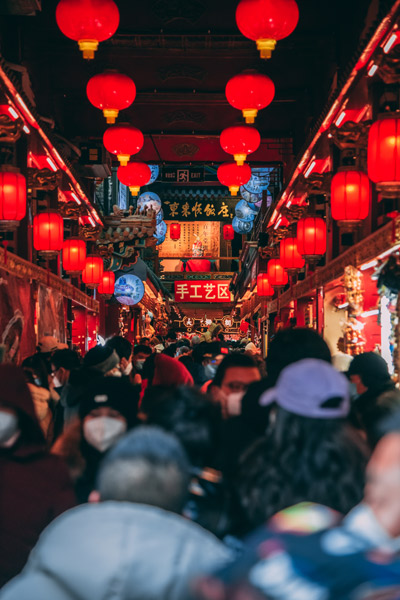

With the arrival of the annual Spring Festival holiday and the relaxation of many of the COVID-19 control measures within China, I made the decision to remain in Beijing in a bid to avoid the inevitable rush of tourists and migrant workers returning home for the vacation.
After a particularly lazy few days at home, due to a sudden drop in temperature here in the capital and with many places being closed for the holiday, I eventually plucked up the courage to brave the cold and made my way to Qianmen Street, located on the Central Axis of Beijing.
Qianmen Street, originally named Zhengyangmen Street, has an extensive history of almost 600 years, and a variety of time-honored brands, modern stores, historical architecture and a tram line running the length of the street. It has become a popular spot for locals and tourists alike.
Having visited this area several times over the past few years, I believed I knew what to expect in regard to crowds. However, I failed to remember a few important things, primarily that I have only lived in Beijing during the time of the pandemic when crowds would have undoubtedly been smaller, and that the appetite for travel due to the combination of Spring Festival and the easing of restrictions would lead to an overwhelming number of visitors.
As wide as Qianmen Street is, traversing it was at times testing, and taking photos was even more of a challenge. After eventually turning off the main avenue, I forced my way into one of the side streets, named Dashilan, which is more akin to a traditional hutong and has an interesting story of its own, both in its name and what can be found there.
Pronounced dashila'er by locals and originating in the Yuan Dynasty (1271-1368), the street is one of the oldest and most distinctive commercial hutong in the capital. There are several theories to the origin of the name which translates literally as "big fence", the prominent idea being that wooden "fences" were erected in the street during the Ming Dynasty (1368-1644) for safety purposes, as the street was used for trading and coral production. These fences later burned down, but the name of the street remains to this day.
This narrower hutong has a diverse array of stores, several of which would individually make a visit worthwhile. Particular standouts are the Ma Ju Yuan hat store, the Nei Lian Sheng shoe store, and the Rui Fu Xiang silk store, all of which have impressive wares that go hand in hand with their long histories. There are also well-known pickle stores, tea shops and herbal medicine outlets.
Not far from the western entrance of Dashilan, is Da Guan Lou cinema, which holds the title of the oldest cinema in China, and is still functioning today. Opened in 1905 by Ren Qingtai, a photographer who would later direct China's first motion picture, named Dingjun Mountain, and establish China's first film studio.
Dashilan is a vibrant piece of Beijing's culture and history, and it is worth the herculean battle against the huge crowds to experience what it has to offer.